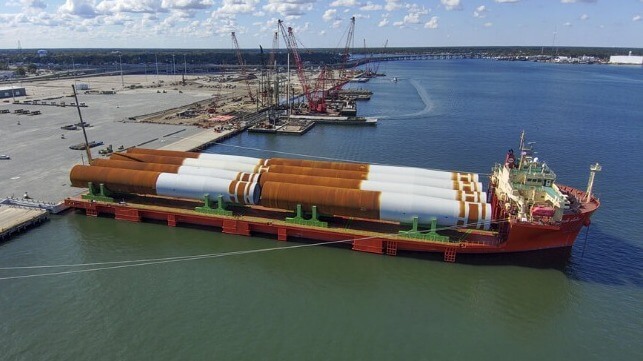The first commercial-scale offshore wind energy project in federal waters has just come online, marking an incredible milestone in America’s offshore wind story. Currently generating over 130 megawatts (MW) of clean electricity, South Fork Wind has created hundreds of good-paying union jobs and is now providing power to about 70,000 homes and businesses in Long Island.
South Fork Wind is just the first of many offshore wind milestones we expect to see in 2024. Here are a few more reasons to be excited about offshore wind this year.
A growing number of American homes and businesses are being powered by offshore wind energy.
South Fork Wind’s 12 turbines are sending power to New York’s electricity grid, and they’re not the only ones spinning off our shores. The Block Island Wind Farm has been powering 17,000 Rhode Island homes and businesses since 2016, and there are two pilot turbines generating power off the coast of Virginia. Vineyard Wind 1, Massachusetts’ first offshore wind project, began supplying power to New England’s electricity grid this January. Once completed, the Vineyard Wind 1 project will be producing 806 MW, enough to power more than 400,000 homes and businesses.
That means that by the end of this year, offshore wind will be producing enough clean energy to power nearly 500,000 homes and businesses across the Northeast while reducing carbon emissions by over 1.8 million metric tons per year. That’s the equivalent of taking approximately 390,000 cars off the road annually!
Not only are these offshore wind projects generating reliable, renewable energy and avoiding pollution, but they’re also creating good-paying local jobs with strong labor standards. South Fork Wind construction relied heavily on skilled union workers, and nearly 1,800 workers have already contributed to the Vineyard Wind project. Hear from one of those workers on the power of an offshore wind job:
Policymakers are doubling down on offshore wind energy.
State and federal policymakers continue to see the promise of offshore wind, and they are taking action to make it happen. This year, state leaders are taking proactive steps to boost project development, such as enacting a new multi-state coordinated procurement model for Massachusetts, Rhode Island, and Connecticut and expediting rebid processes for New York projects. Already this year, New York has awarded 1,734 MW and New Jersey has awarded 3,742 MW of new contracts, demonstrating the continued and strong interest in offshore wind playing a major role in their states’ energy portfolios.
On the federal level, the Biden Administration is steadily advancing major project approvals, with six already approved and many more moving through the environmental review process and on track for completion this year. 2024 is also expected to bring a second offshore wind lease auction for the Gulf of Mexico as well as new lease sales off the Oregon Coast, in the central Atlantic, and in the Gulf of Maine. Thanks to this momentum, the number of states that will benefit from offshore wind energy is expected to grow for years to come.
The offshore wind industry is sparking investments and spreading benefits across the country.

Off the coast of Virginia, the largest U.S. offshore wind project yet is set to start construction. Coastal Virginia Offshore Wind (CVOW) is a 2.6-gigawatt offshore wind project that will power up to 660,000 homes and businesses. Each year of its construction will create 900 Virginia jobs and ongoing operations will support 1,100 jobs in the Hampton Roads area.
Hampton Roads isn’t the only port abuzz with offshore wind activity. ProvPort in Rhode Island is preparing for the construction of Revolution Wind, Connecticut and Rhode Island’s first utility-scale offshore wind project. Revolution Wind will deliver 400 megawatts of offshore wind power to Rhode Island and 304 megawatts to Connecticut, powering over 350,000 homes across the two states.
From Texas shipyards building offshore wind vessels to steel plates being manufactured in Kentucky, offshore wind’s supply chain continues to ramp up to meet the needs and promise of this growing industry in the U.S.. A new, high-tech marine terminal that will support building and operating offshore wind turbines in Humboldt County, California just won a nearly half-billion dollar grant from the federal government. Meanwhile, US Forged Rings Inc. unveiled a $700 million investment in an offshore wind turbine fabrication facility on the East Coast. This facility could make the first American offshore wind towers and hopes to use 100% U.S.-made materials.
Offshore wind is very popular with the American people.
According to a new poll released earlier this year by Turn Forward and Climate Nexus, the majority of U.S. coastal county residents support offshore wind development. Republicans, Democrats, and Independents consider offshore wind to be a reliable source of energy that’s good for American energy independence and our economy. This poll reiterates what past polls have shown: Like the winds blowing off U.S. coasts, support for offshore wind here is strong.
The case for offshore wind continues to get stronger.
The need for locally-produced power is surging across the country. With one of the largest offshore wind resources in the world, the U.S. has a clear opportunity to tap into offshore wind and meet growing electricity demands. Nearly 40% of the U.S. population lives on the coast, which means demand for energy is particularly high in coastal states. Thankfully, the domestic and abundant energy from offshore wind can help make our energy system more reliable and can strengthen American energy security by reducing our reliance on foreign energy imports and fossil fuels.
Offshore wind is poised to be a key component of America’s vital clean energy future. See that growth in action by following Turn Forward on social media at @TurnForwardWind on Facebook, X, and Instagram.

